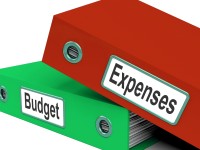How do you determine how much you can afford to pay for a house? And, even more to the point, how do you figure how large a mortgage payment to take on? We found out that the way NOT to do it is to listen to what mortgage lenders tell you that you can afford. Because to follow their advice could easily make you house poor. So we have never gone by how much lenders have told us we could afford to pay for a house. To quote my wife’s immortal words: “We are not idiots.”
Why would she say that? Because the way lenders calculate is premised in such a way that the result of their home affordability equation will seriously – or totally – box you in financially. Simply put, their calculations push you into becoming house poor by inducing you to naively buy too much house. In our case, about twice as much house as we needed to be happy and satisfied. And the lenders would have done that to us not once but 3 times over the past 20 years. They would have kept us house poor for 2 decades.
Here’s what I mean.
Conservative lenders will allow up to 28% of monthly income, including escrow, to go to the mortgage payment. More liberal lenders will allow up to 33%. Even at the lower 28% allowance, lenders have consistently high-balled how much to pay for a house. At least in our case and in our view.
Our First House. High-Balled.
When we bought our first house in 1992 , our combined gross monthly incomes totaled about $7500. We had $10,000 to bring to the closing table as a downpayment on whatever house we bought. Well, our lender’s calculation indicated that we could afford a $2000 monthly mortgage payment. And that meant, factoring in our downpayment, that we could pay up to $240,000 for a house. In a pig’s eye.
What we did buy was a very special 3-bedroom, 2-bath vintage 1920’s home in a lushly landscaped classic neighborhood less than 3 miles form the city center and my office. The two of us had more than enough room in that house, which came with amazing finishes and numerous mature fruit trees. And for which we paid $110,000 with $100,000 of that financed at 7% interest.
Our mortgage payment was about $1000 a month. Which was half of what the lender would have allowed. And for the 8 years we lived in that house, instead of being perennially house poor we banked and invested the extra $12,000 a year which would otherwise have gone to an overblown mortgage payment – if we had listened to our lender.
When we sold this house, we walked away with $80,000 from the sale and had added $96,000 to our financial independence stash from the extra mortgage money we had not shelled out.
Our Second House. High-Balled Again.
When a job opportunity for my wife caused us to relocate in the year 2000, our combined gross incomes had risen to about $11,700 a month. And what our lenders thought we could pay for that next house had also risen accordingly. This time, the lenders thought we could afford up to a $3100 monthly mortgage. (Say what?!) Factoring in our intended $40,000 downpayment, the lender’s calculations would have allowed us to buy a $480,000 house. That’s when my wife looked at me, shook her head, and pronounced “We are not idiots.”
We ended up buying a 3-bedroom, 3-bath Cape Cod on two-and-a-half acres with a full finished basement and an 800-square-foot detached garage. We paid $200,000 for it and took on an $1100 plus-or-minus monthly mortgage payment (thanks to a lower interest rate and no PMI). That was $2000 a month less than the lender would have allowed. And, instead of being made house poor, for the 12 years we lived there we banked and invested that extra $24,000 a year.
When we sold that house, we walked away with $165,000 from the sale and had added $240,000 to our financial independence stash from the extra mortgage money we had not shelled out.
By which time, and in good part due to the $336,000 we had been able to plow into extra investments instead of into extra mortgage costs, we were in position to earlier retire. And that brought us to house number 3.
Our Present House. Still High-Balled.
Our combined passive and side gig income is now about $8300 a month. We were ready to put $100,000 down on our earlier retirement home. And this time the lenders were prepared to let us go as high as $2300 on our monthly mortgage payment. Which we still thought was nuts.
So we bought a largish 3-bedroom, 2-bath brick house on two-and-a-half rural acres that included a detached garage, a huge metal storage outbuilding and an absolutely gigantic pole barn. And we paid $200,000 for it, financing half. The monthly mortgage payment is under $700. And the “leftover” $1600 a month covers a substantial portion of our basic living expenses.
And we are job free. Earlier retired. Which I don’t believe we would be if we had listened to all those mortgage lenders and kept ourselves house poor all those years.
So… don’t you listen to lenders either. Opt for becoming financially independent. Instead of house poor.
# # #
image courtesy of renjith krishnan at freedigitalphotos.net








It’s funny how a lot of people see the amount they can borrow as a personal validation. You know, ‘we think you’re wonderful so we’re going to let you borrow ‘$n’. I see it as a longer debt sentence regardless of how much you’re currently earning.
It’s amazing to see the dollars those choices have put in your pockets and not the bank’s.
In the words of Admiral Ackbar: It’s a trap!
Mortgage lenders are pretty skilled at selling you the American dream – a large home in a high-end neighborhood. We recently paid off our mortgage and saved quite a bit in interest. For the first time, it feels wonderful not having a house payment. Although, property taxes are still a killer. People tell use we should have left the money in the stock market, but the feeling of being debt free is just great. I think the same concept applies to buying cars, clothing, etc. Lenders make you feel better about yourself if you buy more. Don’t fall into the trap like most Americans. Thanks for the article.
A mortgage affordability calculator I tried the other day said we could afford a $800,000 mortgage. Ummmm….no! I don’t believe those things at all. I hate the idea of being house poor too, which is why we bought a house that costs $187K. It may not be fancy, but I sleep great at night.
Same here, Holly. We own our house; it doesn’t own us. 😉
At my 10yr HS reunion (many, many years ago), we assembled in a large new house of a classmate (hs teacher and her husband). The house payment took her WHOLE paycheck and they lived on his (railroad engineer) paycheck.
Another classmate spouted up he had saved and paid “cash” for his home. Some were overly impressed but the real joke was, he paid “one dollar” for an older house and had it moved to an acre of land his pareents gave him.
Glad I found you through MMM forum! I might mention the math works pretty much the same whether one pays cash or borrows. Our house was a major fixer upper. 3100 sq ft on 3 acres for 75k, 90 k with sweat equity. We cashed out 35k and paid off debt. Home is now worth 220 and I’m looking at more 75k houses. Which we can pay for in cash with our equity. Of course we’ll finance at 3.25 and invest the difference. I guess in our case we are house rich?
You will be… as soon as you cash out all that lovely house equity money in a sale and go on to another reasonably priced house. 😉